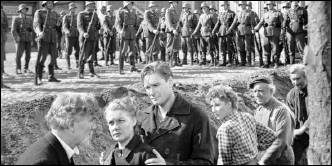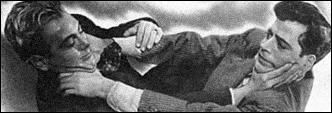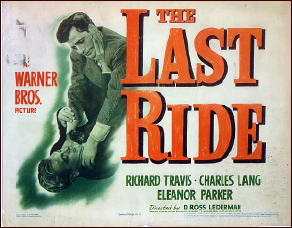JOYCE HOLMS – Payment Deferred. Headline, UK, hardcover, 1996; paperback, 1997. Bloody Brits Press, US, softcover, 2007.

The cover bills this as “A Fizz & Buchanan Mystery,†which was intriguing right then and there, because (a) I admit that Joyce Holms was a new name to me, and (b) what’s (who’s) a Fizz? Doing some investigation on my own, it was not difficult to discover that Payment Deferred is the first of [nine] in a series, and why I’d happened to have never heard of the author is that [at the time I read this book] none of them have been published in this country.
I’ll get back to that particular point later, I think. Of the pair of sleuths working out of Ms. Holms’ books, let’s take Tam Buchanan first, as it’s much simpler that way. The town is Edinburgh, and Tam (male) is a lawyer who donates a morning a week to a free legal clinic, a more-or-less straight-and-narrow sort of fellow. As for “Fizz,†I think I’ll do some quoting from pages 7 and 8:
Tam arrives late to find “a plump girl of about seventeen†waiting for him.
“You’re waiting to see me, are you?â€
She had a sweet, dimpled face and an expression of unassailable innocence. “Well,†she said with a hesitant smile, “that rather depends on who you are.â€
The discrepancy between what his eyes saw and what his ears heard was so great that Buchanan was momentarily at a loss. It was like being savaged by a day-old chick, which was clearly impossible, so that he had to assume that she had not intended the put-down but was merely trying to sound sophisticated, or some such rubbish.
“I do beg your pardon,†he said, with exaggerated politeness, and then regretted it. She was, after all, just a kid, and besides, he should have had the common decency to introduce himself before barking at her. “I’m Tam Buchanan, Legal Advice.â€
She gave him a shy nod and offered a small but surprisingly strong hand. “In that case I am waiting to see you. I’m your new assistant. The name’s Fitzpatrick.â€
And so from here the relationship begins, full of sparks and brief bursts of annoyance and vexation (on both sides, but mostly Tam’s). Here’s another long quote from much toward the end of the book (page 291):

Bloody Fizz!
Buchanan was equally disgusted at himself for (a) ever letting her into his life, and (b) being markedly less than enthusiastic to be rid of her.
She was a pain in the neck. Let’s face it, she was horrendous. She was an inveterate liar, a manipulator, selfish, opinionated, miserly, and didn’t give a hoot in hell about anyone but herself. Her philosophy, as propounded by herself, was: everything I have is yours and everything you have is mine. Which was fair enough till you remembered that she didn’t have anything you’d want.
On the other hand, when she was in a good mood – which, okay, was almost always – she was quite nice to be around. She was different. She made you see things in ways you hadn’t seen them before. Also, she had a strange kind of innocence about her, even though you couldn’t trust her with the gold fillings in Grandma’s teeth. But she was honest. That was the funny thing. Way down deep, where it counted, she was as honest a person as he’d ever met.
However, be that as it may, he was rid of her now, and he wasn’t about to change that, regrets or no regrets. Common sense dictated that he learn his lesson and steer clear of her from now on.
Obviously the man is hooked on her. And, no, all first impressions aside, she’s not seventeen, either. More like twenty-six. She’s starting law school in the fall, and working for Tam is to get her foot in the door, and she has no intentions of being a mere secretary. She begins assisting on Tam’s next case almost before he knows there is one.
Which consists of trying to clear the name of an old (and rather dull) friend of Tam’s, Murray Kingston, who has just been released from prison after being convicted of molesting his young daughter.
Who had anything to gain from the false conviction – who could have wanted Murray out of the way for any reason – and who could have faked all of the evidence that put him into prison for three years?
Well, yawn. This is not the most gripping of tales – there’s a heaping abundance of legwork and around page 120 the book gets really talky. Even though (of course) there’s eventually a murder to solve, the real fun is watching the free-spirited Fizz walk loops around the laid-back Buchanan. For the edgiest of relationships since Maddy and David — back before they jumped the shark and “did it†– this is the book you’ll want to read next.

JOYCE HOLMS – Foreign Body. Headline, UK, hardcover, 1997; paperback, 1997. Bloody Brits Press, US, softcover, 2008.
Authors, on occasion and for various reasons, go in their own direction, and that is not always where the reader is going, or wants to, and he or she (the reader) is left leaning the wrong way, and sometimes in the most awkward of positions.
Which is to say, strangely enough, in this the second adventure of Fizz and Buchanan, the edge is gone. Vanished. Only the slightest sense of sexual tension between the two mystery solvers remains, showing itself only now and then, and mostly then.
There’s also a sizable gap in time between the previous book and this one. Fizz, having gotten fired from Tam’s legal clinic, has somehow attached herself to his legal firm itself – and there’s got to be a story there that’s (apparently) never going to be told.
What we do get, as a rather inadequate substitute – I’m being Uncle Grumpy here – is a intimate look into Fizz’s background – the small Scottish village where she grew up, orphaned at an early age, and raised her elderly grandfather.
Persuading Tam to recuperate from an inconvenient gall bladder operation in Perthshire, around Am Bealach where Fizz’s grampa lives, Fizz also has an ulterior motive – persuading Tam to also take an interest in the strange disappearance of Old Bessie, an elderly villager Fizz was fond of. In the meantime, another mystery is encountered – that of a strangely behaving camper with a tent full of weird objects including a blonde wig and a mannequin’s hand.
Can the two cases be connected? Have you not read enough crime fiction to know the answer without asking? You realize of course that the twist might be that they are not – and I’ll never tell.
Once the reader (that’s me) rights himself (or herself, if it’s you, and the pronoun is appropriate) this pair of semi-dueling detectives does do themselves a fair amount of justice on the pair of mysteries with which they’re confronted.
Once again the book plods a little in the middle, but the pieces of the puzzle are painstakingly shaped and given time to develop – perhaps a little too painstakingly – but do stay with them. What better reading experience can there be when all sorts of mysterious occurrences are eventually explained and slide into place?
The Fizz and Buchanan series —
1. Payment Deferred (1996)
2. Foreign Body (1997)
3. Bad Vibes (1998)
4. Thin Ice (1999)
5. Mr Big (2000)
6. Bitter End (2001)
7. Hot Potato (2003)
8. Hidden Depths (2004)
9. Missing Link (2006)


